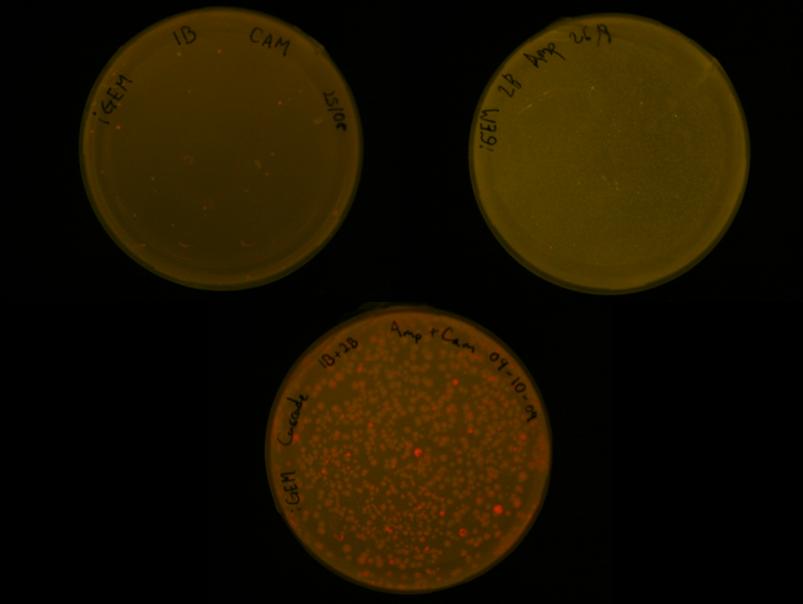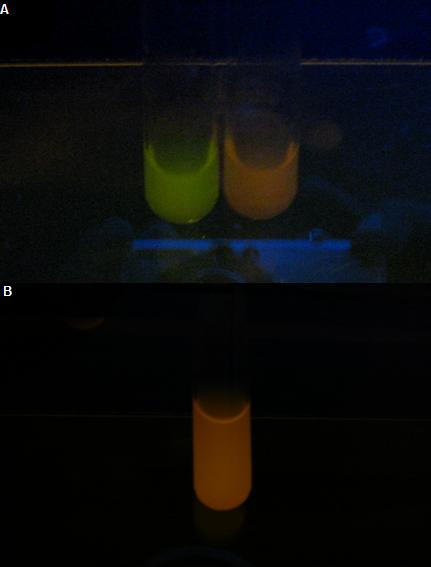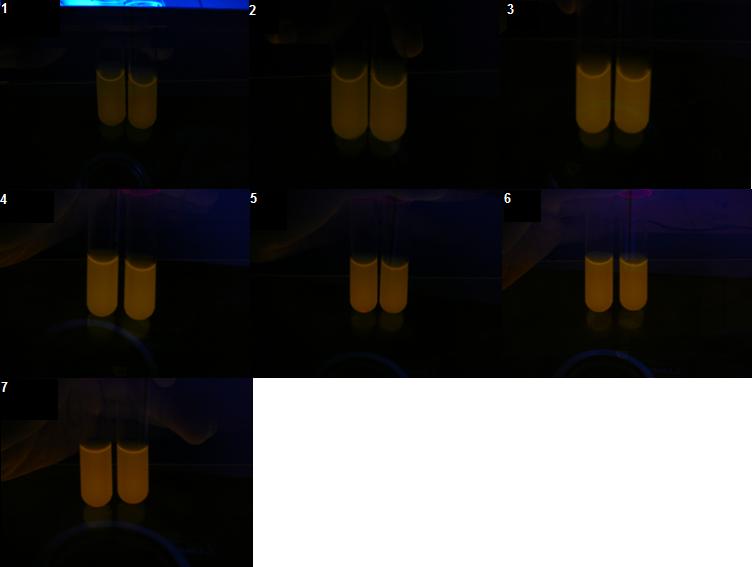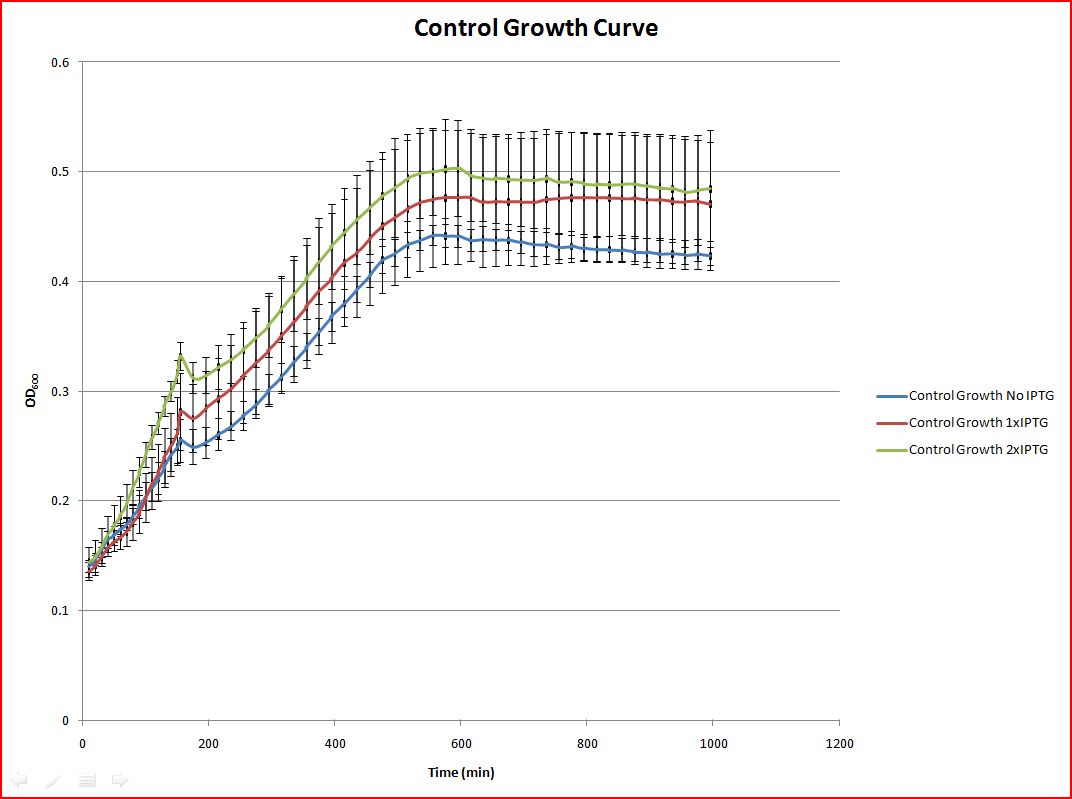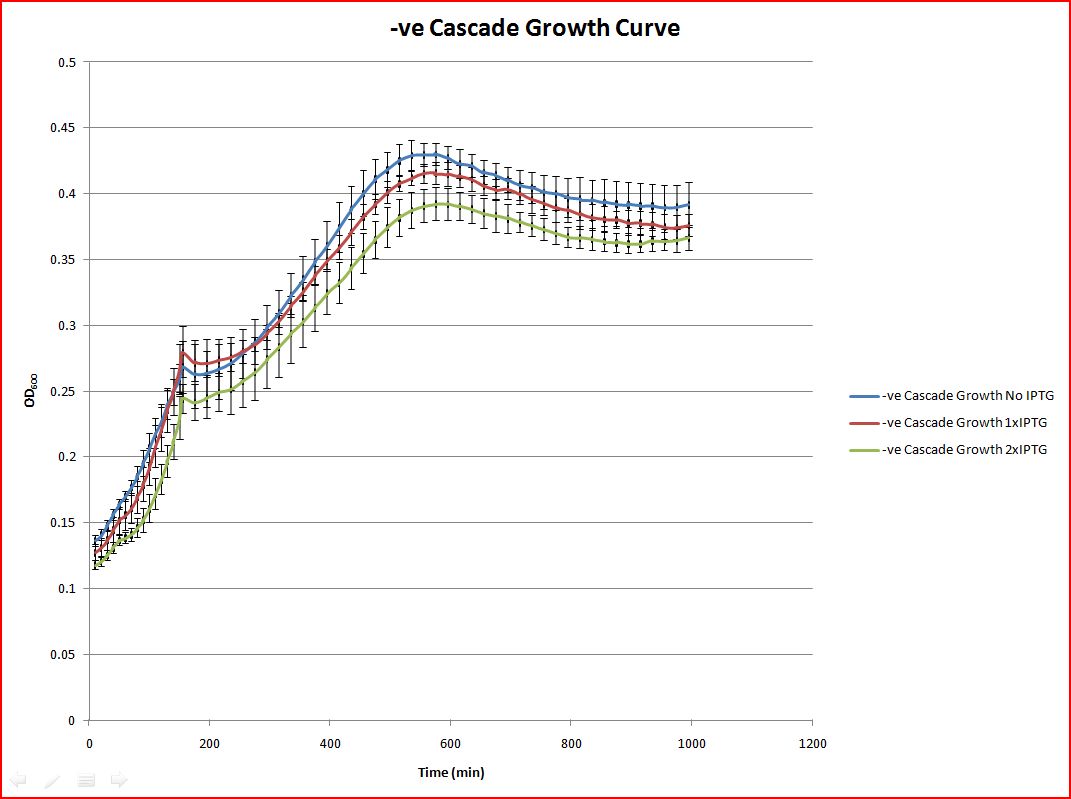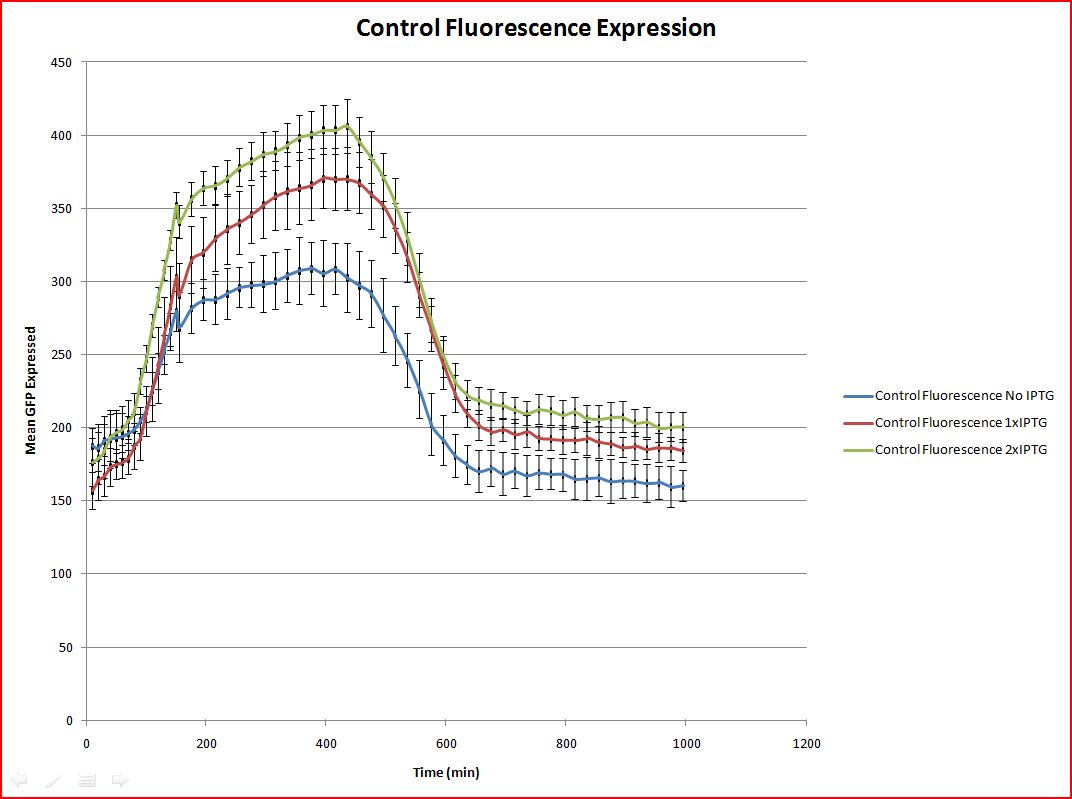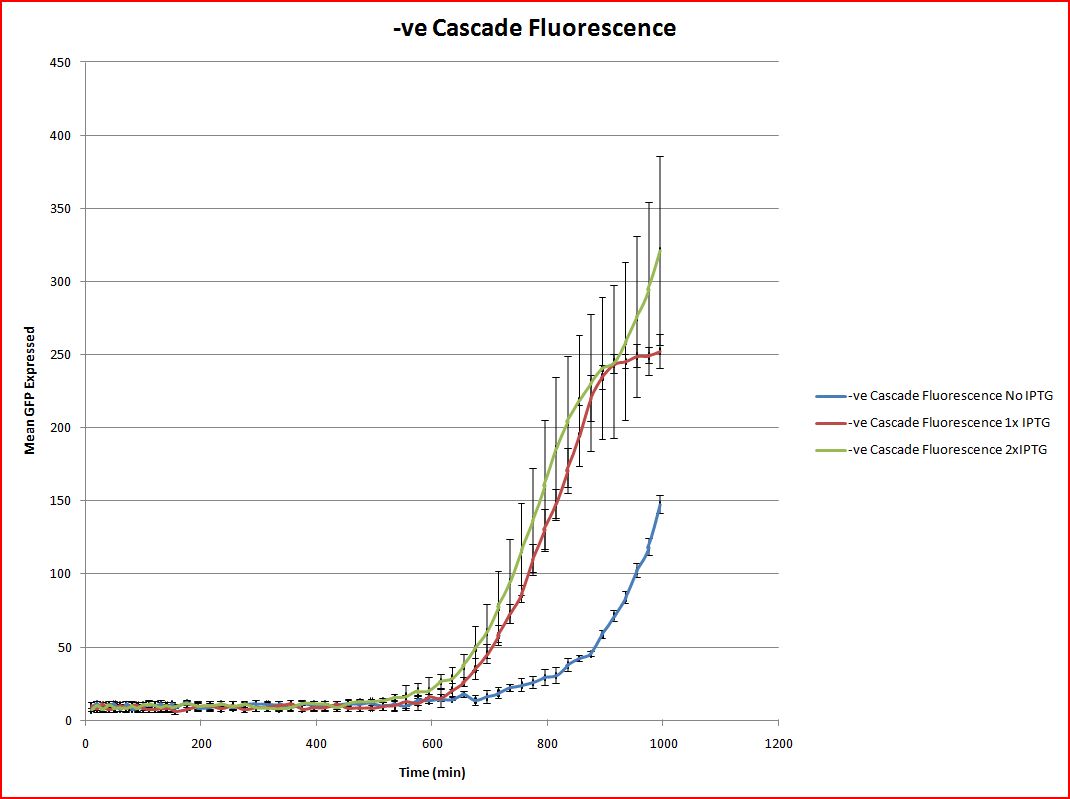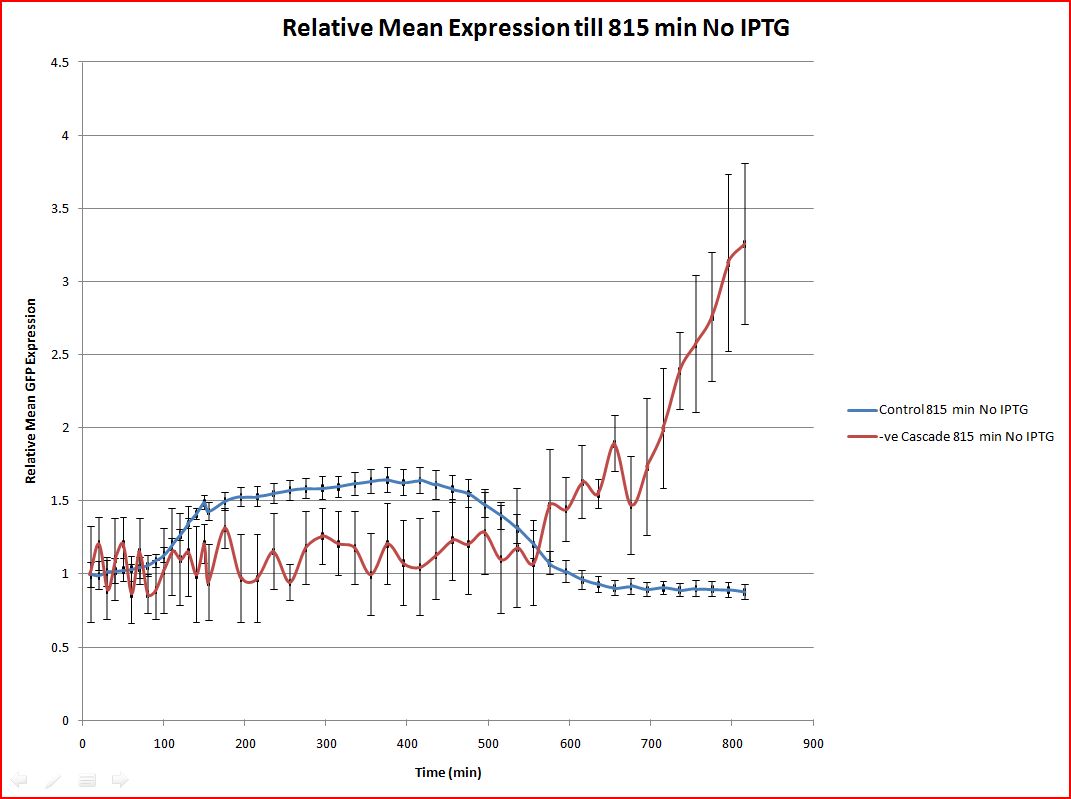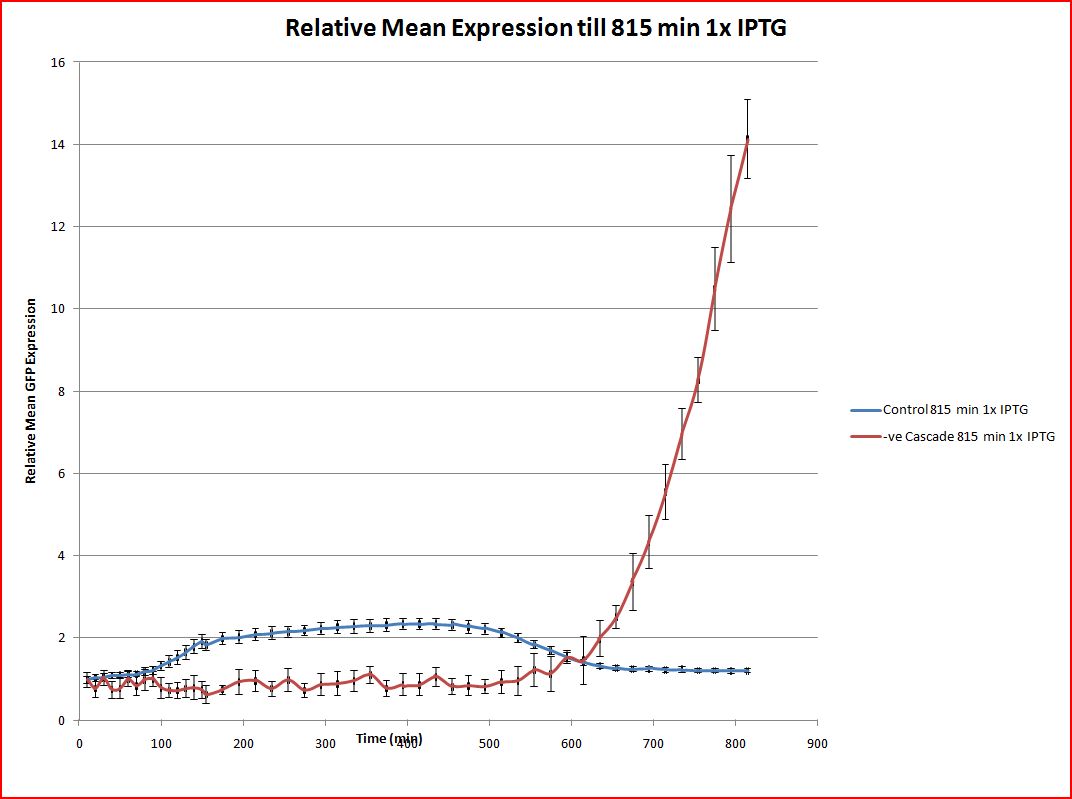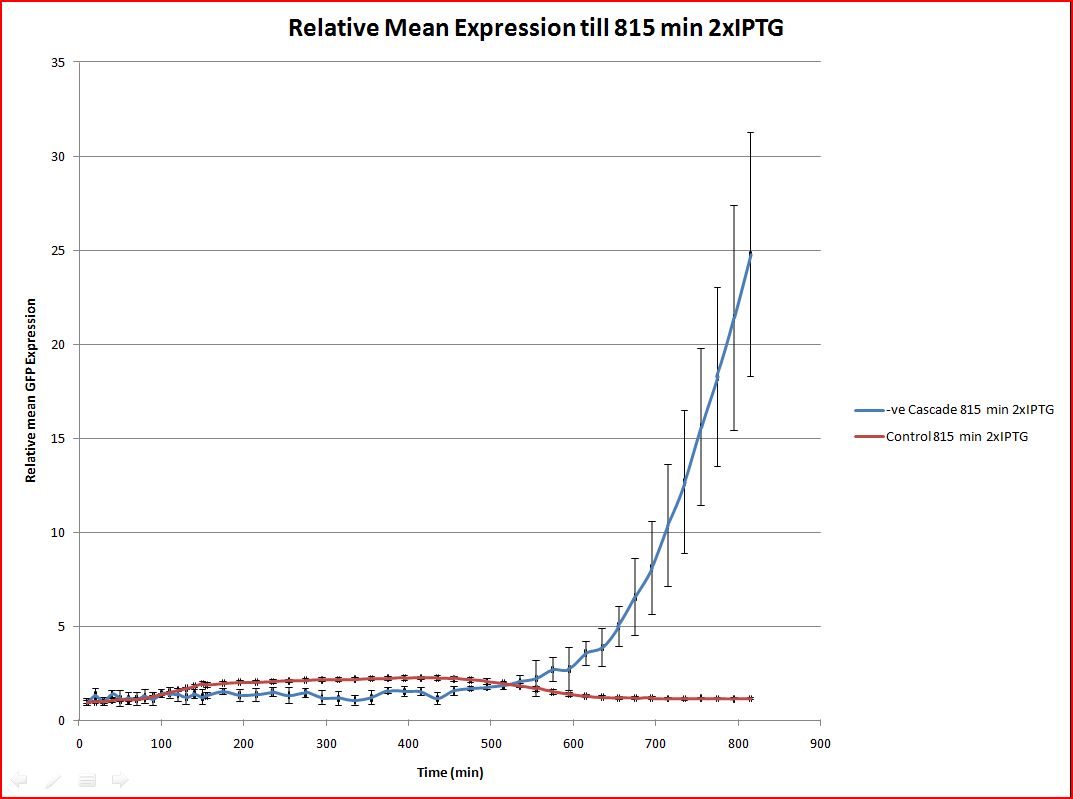Team:TUDelft/Results
From 2009.igem.org
(→Results) |
(→Results) |
||
| Line 26: | Line 26: | ||
The tube containing cells with both plasmids were used to perform a simple kinetic in order to have preliminary results for the delay time. 1mL was transferred to a tube with 4mL fresh minimal medium and incubated for 1 h at 37°C and 175 rpm. This procedure was done twice in order to have a control. After 1 h one tube was induced with 0.2 mM IPTG and the glow was followed for 9 h. | The tube containing cells with both plasmids were used to perform a simple kinetic in order to have preliminary results for the delay time. 1mL was transferred to a tube with 4mL fresh minimal medium and incubated for 1 h at 37°C and 175 rpm. This procedure was done twice in order to have a control. After 1 h one tube was induced with 0.2 mM IPTG and the glow was followed for 9 h. | ||
| - | As appreciated in figure C, no change | + | As appreciated in figure C, no change in color was noticed and the red glow was increasing over time indicating the growth of the culture. Unfortunately, these results proved once again the non functionality of the device under the circumstances tested. Further experiments, see below, were performed with some promising results. Besides, the presence of both plasmids in one cell was not confirmed. |
[[Image:cascadekinetic.jpg|center|thumb|550px|Figure C. Preliminary synthetic transcriptional cascade test. The pictures were taken at 1) t=0 (IPTG induction, left tube in all images), 2) t=1h, 3)t=2h, 4)t=3h, 5) t=5h, 6) t=7h, 7) t=9h]] | [[Image:cascadekinetic.jpg|center|thumb|550px|Figure C. Preliminary synthetic transcriptional cascade test. The pictures were taken at 1) t=0 (IPTG induction, left tube in all images), 2) t=1h, 3)t=2h, 4)t=3h, 5) t=5h, 6) t=7h, 7) t=9h]] | ||
Revision as of 01:07, 22 October 2009
Results
Main Results
- Assembly of plasmid 1 ([http://partsregistry.org/Part:BBa_K175046 K175046]) and 2 ([http://partsregistry.org/Part:BBa_K175047 K175047]).
- Partial confirmation of sequence of both plasmids.
- Transformation in Escherichia coli
- Confirmation of both biobrick individual functionality.
- Characterization of the plasmids 1 and 2 by fluorescence experiments
Results
The first results obtained were the successful assemblies of the plasmids 1 ([http://partsregistry.org/Part:BBa_K175046 K175046]) and 2 ([http://partsregistry.org/Part:BBa_K175047 K175047]) (see the plan). The biobricks were electroporated into Escherichia coli TOP10 cells (see protocols). Besides, The samples were sent as miniprep DNA to sequence; with this it was possible to confirm the presence of the last part of the biobricks (RBS ([http://partsregistry.org/Part:BBa_B0034 B0034]) + GFP ([http://partsregistry.org/Part:BBa_E0040 E0040]) + Terminator ([http://partsregistry.org/Part:BBa_B0015 B0015])). Further investigation on the sequence should be done.
250 µL of the E. coli TOP10 cells carrying either the plasmid 1 or 2 were plated in an LB agar Petri dish adding the proper selection antibiotic and incubated at 37ºC overnight. The colonies in the plate for plasmid 1 showed red fluorescence and the colonies in the plate for plasmid 2 showed green fluorescence (data not shown). These results were in agreement with the expected fluorescence, Ptet ([http://partsregistry.org/Part:BBa_R0040 R0040]) acts as a constitutive promoter in the absence of its repressor TetR ([http://partsregistry.org/Part:BBa_C0040 C0040]), therefore, the production of cI ([http://partsregistry.org/Part:BBa_C0051 C0051]) and RFP ([http://partsregistry.org/Part:BBa_E1010 E1010]) was present in the cells. Similar explanation could be used for the interpretation of the green glow in plasmid 2.
The delay-device is formed by the two plasmids. Therefore, both plasmids were introduced into the TOP10 cells, followed by plating and culturing them using the same conditions mentioned above. In this case, the plates and culture tubes were glowing red, which is in agreement with our expectations. However in preliminary tests (data not shown), the addition of IPTG to the medium did not lead to the change of fluorescence from red to green as expected. These preliminary results indicate the lack of function of the plasmid 2 when the both plasmids are present. This conclusion is only accepted if the presence of the two plasmids in one cell is confirmed, however we could not confirm it; thus it will remain as another potential explanation.
Derived from the results in other sections of this subproject (see Lock/Key results), the plasmids were also transformed in (K12) electro-competent cells. 250 µL of the E. coli (K12) cells carrying either the plasmid 1, plasmid 2 or both were plated in an LB agar Petri dish adding the proper selection antibiotic and incubated at 37ºC overnight. As the previous results, the plates with cells containing the plasmid 1 and the colonies carrying both plasmids glowed red and the cells with the plasmid 2 glowed green (Figure A). One colony from each plate was inoculated in a 4 mL culture tube with minimal medium and the appropriate antibiotic. The tubes were incubated overnight at 37°C and 175 rpm. Once again, the expected results were confirmed as showed in the figure B.
The tube containing cells with both plasmids were used to perform a simple kinetic in order to have preliminary results for the delay time. 1mL was transferred to a tube with 4mL fresh minimal medium and incubated for 1 h at 37°C and 175 rpm. This procedure was done twice in order to have a control. After 1 h one tube was induced with 0.2 mM IPTG and the glow was followed for 9 h.
As appreciated in figure C, no change in color was noticed and the red glow was increasing over time indicating the growth of the culture. Unfortunately, these results proved once again the non functionality of the device under the circumstances tested. Further experiments, see below, were performed with some promising results. Besides, the presence of both plasmids in one cell was not confirmed.
Then based on the paper [10], which created a similar transcriptional cascade, we performed the fluorescence experiment in a 96 well plate reader with GFP specific filter. The results and discussion of that experiment are shown and explained in next section.
Fluorescence Experiments
The control organism developed for this experiment has two plasmids. One is plasmid 1 of negative cascade and other is a pLacI controlled GFP generator. Hence it resembles the negative cascade organism in all ways other than the cascade initiating gene (TetR). Even though our modelling showed that the delay time caused by the cascade is around 6 Hr 15 mins without leakage, at first we guessed that our delay device would cause only delay in less than 2 hours since we saw leaky GFP expression already in control colonies. Hence the fluorescent reading after IPTG induction (0.1mM and 0.2mM)(see for protocol here) in the 96 well plates were taken only for 2 and half hours and the readings were not giving promising results. Hence with the help our supervisors to find which part of the growth curve are we in, we ran an overnight experiment with continuing the same experiment for 14 hours more, hence in total we would get a result for 16 and half hours.
The results for the positive control and negative cascade (experiment) are given in this xls attached here. The results were consolidated and shown in graphs below.
Both the figures 1 and 2 show the growth curves of control and negative cascade. They also show that the readings were taken till the stationary phase of growth (995 mins). Also both negative cascade and control have shown same growth pattern. This is very good for our fluorescence measurements interpretation.
In figure 3 the fluorescence (GFP) measurements of control is shown. We can see very clearly that IPTG induction has an effect on the increasing change in fluorescence. Also the fluorescence decreases after a period which show that GFP gets degraded since it has LVA tag and also IPTG has been fully consumed. Also in figure 4 the negative cascade starts to produce fluorescence very lately around 600 minutes. This shows that Delay device works fine.
Also from the above graphs we found that the GFP is produced in non induced E.coli (K12) cells (both control and negative cascade containing cells) which is supposed to have LacI repressor. We think the reason could be the LacI repressor produced by the cells were not enough to repress the higher number of pLacI in the plasmids. hence to characterize the negative cascade plasmids we used relative mean (mean/mean at time of induction) and constructed the comparison graphs of control and negative cascade samples under the three conditions (No IPTG, 1xIPTG and 2xIPTG) which are shown in figures 5,6 and 7. From the figures it is clear that the change in measurement is statistically more than the change in noise.
In figure 5, it shows that the non induced negative cascade sample shows high variability in GFP expression in initial stages then it steadily increases higher than the control. This same behavior is seen in other 1xIPTG and 2xIPTG conditions. Also interestingly all the Negative Cascade samples starts to produce relatively higher amounts of GFP around 595 to 615th minute which is also possible according to the model developed in which there could be a condition when the delay time could reach high values if the cI produced is degraded slowly. Thus the experiment proves that the delay time caused by our transcriptional cascade is around 10 hours (600 min) with high transcriptional leakage of GFP.
 "
"
